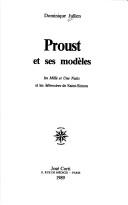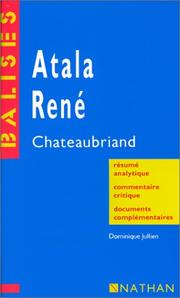| Listing 1 - 10 of 13 | << page >> |
Sort by
|

ISBN: 2714303277 Year: 1989 Publisher: Paris Corti
Abstract | Keywords | Export | Availability | Bookmark
 Loading...
Loading...Choose an application
- Reference Manager
- EndNote
- RefWorks (Direct export to RefWorks)
Proust, Marcel --- Influence (Literary, artistic, etc.) --- Narration (Rhetoric) --- History --- Proust, Marcel, --- Saint-Simon, Louis de Rouvroy, --- Technique. --- Knowledge --- Literature. --- Influence. --- Arabian nights.
Book
ISBN: 3030047172 3030047164 Year: 2019 Publisher: Cham : Springer International Publishing : Imprint: Palgrave Macmillan,
Abstract | Keywords | Export | Availability | Bookmark
 Loading...
Loading...Choose an application
- Reference Manager
- EndNote
- RefWorks (Direct export to RefWorks)
This book follows the renunciation story in Borges and beyond, arguing for its centrality as a Borgesian compositional trope and as a Borgesian prism for reading a global constellation of texts. The renunciation story at the heart of Buddhism, that of a king who leaves his palace to become an ascetic, fascinated Borges because of its cross-cultural adaptability and metamorphic nature, and because it resonated so powerfully across philosophy, politics and aesthetics. From the story and its many variants, Borges’s essays formulated a 'morphological' conception of literature (borrowing the idea from Goethe), whereby a potentially infinite number of stories were generated by transformation of a finite number of 'archetypes'. The king-and-ascetic encounter also tells a powerful political story, setting up a confrontation between power and authority; Borges’s own political predicament is explored against the rich background of truth-telling renouncers. In its poetic variant, the renunciation archetype morphs into stories about art and artists, with renunciation a key requirement of the creative process: the discussion weaves in and out of Borges to highlight modern writers’ debt to asceticism. Ultimately, the enigmatic appeal of the renunciation story aligns it with the open-endedness of modern parables.
Latin American literature. --- Comparative literature. --- Literature, Modern-20th century. --- Latin American/Caribbean Literature. --- Comparative Literature. --- Twentieth-Century Literature. --- Comparative literature --- Literature, Comparative --- Philology --- History and criticism --- Literature, Modern—20th century. --- Literature, Modern --- Literature --- 20th century.
Book
ISBN: 9781433112690 Year: 2011 Publisher: New York, N.Y. Peter Lang
Abstract | Keywords | Export | Availability | Bookmark
 Loading...
Loading...Choose an application
- Reference Manager
- EndNote
- RefWorks (Direct export to RefWorks)
Comparative literature. --- Literature --- Littérature comparée --- Littérature --- History and criticism. --- Histoire et critique --- Comparative literature
Digital
ISBN: 9783030047177 Year: 2019 Publisher: Cham Springer International Publishing :Imprint: Palgrave Macmillan
Abstract | Keywords | Export | Availability | Bookmark
 Loading...
Loading...Choose an application
- Reference Manager
- EndNote
- RefWorks (Direct export to RefWorks)
This book follows the renunciation story in Borges and beyond, arguing for its centrality as a Borgesian compositional trope and as a Borgesian prism for reading a global constellation of texts. The renunciation story at the heart of Buddhism, that of a king who leaves his palace to become an ascetic, fascinated Borges because of its cross-cultural adaptability and metamorphic nature, and because it resonated so powerfully across philosophy, politics and aesthetics. From the story and its many variants, Borges’s essays formulated a 'morphological' conception of literature (borrowing the idea from Goethe), whereby a potentially infinite number of stories were generated by transformation of a finite number of 'archetypes'. The king-and-ascetic encounter also tells a powerful political story, setting up a confrontation between power and authority; Borges’s own political predicament is explored against the rich background of truth-telling renouncers. In its poetic variant, the renunciation archetype morphs into stories about art and artists, with renunciation a key requirement of the creative process: the discussion weaves in and out of Borges to highlight modern writers’ debt to asceticism. Ultimately, the enigmatic appeal of the renunciation story aligns it with the open-endedness of modern parables.
Comparative literature --- Literature --- literatuur --- boeddhisme --- Borges, Jorge Luis --- anno 1900-1999 --- Caribbean area --- Latin America
Book
ISBN: 2091902004 Year: 1992 Publisher: Paris Nathan
Abstract | Keywords | Export | Availability | Bookmark
 Loading...
Loading...Choose an application
- Reference Manager
- EndNote
- RefWorks (Direct export to RefWorks)
Book
ISBN: 9783030047160 Year: 2019 Publisher: London : Palgrave Macmillan,
Abstract | Keywords | Export | Availability | Bookmark
 Loading...
Loading...Choose an application
- Reference Manager
- EndNote
- RefWorks (Direct export to RefWorks)
This book follows the renunciation story in Borges and beyond, arguing for its centrality as a Borgesian compositional trope and as a Borgesian prism for reading a global constellation of texts. The renunciation story at the heart of Buddhism, that of a king who leaves his palace to become an ascetic, fascinated Borges because of its cross-cultural adaptability and metamorphic nature, and because it resonated so powerfully across philosophy, politics and aesthetics. From the story and its many variants, Borges’s essays formulated a 'morphological' conception of literature (borrowing the idea from Goethe), whereby a potentially infinite number of stories were generated by transformation of a finite number of 'archetypes'. The king-and-ascetic encounter also tells a powerful political story, setting up a confrontation between power and authority; Borges’s own political predicament is explored against the rich background of truth-telling renouncers. In its poetic variant, the renunciation archetype morphs into stories about art and artists, with renunciation a key requirement of the creative process: the discussion weaves in and out of Borges to highlight modern writers’ debt to asceticism. Ultimately, the enigmatic appeal of the renunciation story aligns it with the open-endedness of modern parables.
Book
ISBN: 9782600012539 2600012532 Year: 2009 Volume: 450 Publisher: Genève Librairie Droz S.A.
Abstract | Keywords | Export | Availability | Bookmark
 Loading...
Loading...Choose an application
- Reference Manager
- EndNote
- RefWorks (Direct export to RefWorks)
Scheherazade (Legendary character) in literature. --- European literature --- Schéhérazade (Personnage fictif) dans la littérature --- Littérature européenne --- Arab influences. --- Influence arabe --- Arabian nights --- Influence. --- Schéhérazade (Personnage fictif) dans la littérature --- Littérature européenne --- European literature - Arab influences.
Digital
ISBN: 9782600312530 Year: 2009 Publisher: Genève Librairie Droz
Abstract | Keywords | Export | Availability | Bookmark
 Loading...
Loading...Choose an application
- Reference Manager
- EndNote
- RefWorks (Direct export to RefWorks)
Aucun autre livre, hormis peut-être la Bible ou L’Odyssée, n’a imprégné aussi profondément la littérature que les Mille et une nuits depuis leur apparition en Occident sous la plume de leur premier traducteur, Antoine Galland. De Proust à Salman Rushdie, de Balzac à Naguib Mahfouz, tant d’écrivains amoureux de Schéhérazade partagent cette ambition: réinventer, sans les imiter, les Mille et une nuits. De là l’inépuisable variété de ces réécritures modernes, qui toutes ressemblent au modèle sans pour autant se ressembler entre elles. Pourtant, dans cette profusion, quatre courants dominent, fournissant les quatre volets de la présente étude. La lecture politique des Nuits: le premier chapitre, “Le prince déguisé, symbole politique et motif poétique”, s’attache à un motif qui fera fortune dans le roman populaire du XIXe siècle, celui du héros princier qui, à l’instar du calife Haroun Al-Raschid, se déguise en homme du peuple pour faire le bien. La lecture esthétique: le deuxième chapitre, “Schéhérazade fin-de-siècle”, analyse la réception de la traduction Mardrus dans le milieu littéraire et culturel de la Belle Epoque. La lecture féministe: le troisième chapitre, “Schéhérazade s’émancipe”, montre le rôle-clef de la version Mardrus dans les lectures féministes qui se développent à partir des années vingt, aboutissant à la romancière Assia Djebar et à sa réécriture pessimiste des Nuits dans le contexte de la montée de l’islamisme. La lecture introspective: à travers une analyse du Portrait de l’artiste en jeune singe, variation autobiographique de Michel Butor sur l’ “Histoire du second calender”, le quatrième chapitre, “Schéhérazade au miroir: l’aventure introspective”, se penche sur une tradition interprétative qui voit dans les contes une aventure intérieure, une image du processus créateur. Voici donc, de Restif à Butor, l’histoire de la réécriture française des contes arabes.
Book
ISBN: 9783030047177 Year: 2019 Publisher: Cham Springer International Publishing :Imprint: Palgrave Macmillan
Abstract | Keywords | Export | Availability | Bookmark
 Loading...
Loading...Choose an application
- Reference Manager
- EndNote
- RefWorks (Direct export to RefWorks)
Comparative literature --- Literature --- literatuur --- boeddhisme --- Borges, Jorge Luis --- anno 1900-1999 --- Caribbean area --- Latin America

ISBN: 2091800481 9782091800486 Year: 1990 Publisher: Paris: Fernand Nathan,
Abstract | Keywords | Export | Availability | Bookmark
 Loading...
Loading...Choose an application
- Reference Manager
- EndNote
- RefWorks (Direct export to RefWorks)
| Listing 1 - 10 of 13 | << page >> |
Sort by
|

 Search
Search Feedback
Feedback About UniCat
About UniCat  Help
Help News
News